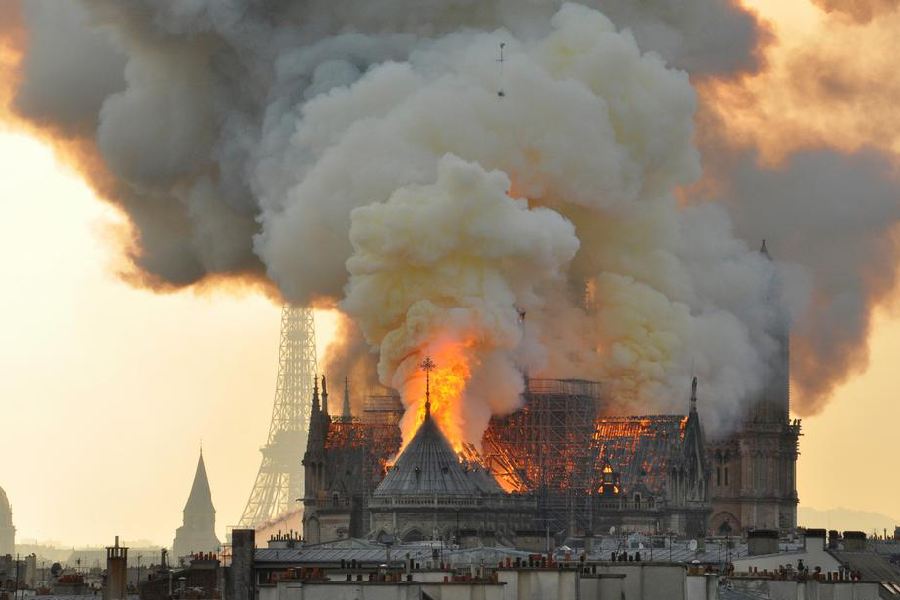The fire was still raging at the Notre Dame Cathedral on April 15, 2019, when French President Emmanuel Macron vowed to renovate and reconstruct the medieval monument within five years.
Since then, work on the Gothic Episcopal church has been in full swing and is apparently on schedule.
"We are meeting deadlines and budget," Philippe Jost, the head of reconstruction efforts, told a French Senate committee in late March. Jost took over the position after his predecessor, ex-General Jean-Louis Georgelin, died while hiking in August 2023.
The cathedral is officially scheduled to reopen on December 8, 2024.
Though it will not be ready in time for the Summer Olympic Games in Paris, as was initially desired, visitors to the French capital can once again see Notre Dame's towering spire following the recent removal of the surrounding scaffolding. The lead roof is also currently being installed.
Fire-prevention features, such as a sprinkler system and compartmentalized sections, are also part of restoration efforts. Ongoing work includes finishing the electric and heating systems and restoring the internal furnishings.

The rebuilt spire has been topped with a golden rooster, imagined as a phoenix, a symbol of rebirth Deutsche Welle
Short circuit or cigarette caused the fire?
Exactly five years have passed since the fire. The historic building was partially destroyed in the process. The Paris fire department fought for four hours before it was able to confine the fire to the wooden roof truss. The west facade with the main towers, the walls of the nave, the buttresses and large parts of the ceiling vault, also the side aisles and choir ambulatories remained stable. Heat, smoke, soot and extinguishing water affected the church furnishings, but here, too, there was no major damage.

Flames and smoke billowed from Notre Dame cathedral in Paris on April 15, 2019 Deutsche Welle
Whether the fire was caused by a short circuit or a construction worker's cigarette is still unclear.
The extent of the destruction was not as great as initially feared. "Thank God not all the vaults collapsed," German cathedral expert Barbara Schock-Werner said in a DW interview at the time. Only three vaults fell in the end.
There was a hole in the choir. The Gothic Madonna, meanwhile, remained intact, although the crossing tower came crashing down right beside her. "That is the miracle of Notre Dame," Schock-Werner said.

The scaffolding around the cathedral is slowly being deconstructed as major restoration nears the end Deutsche Welle
Window restoration in Cologne
Images of the burning cathedral went around the world. They triggered worldwide consternation and a wave of willingness to help.
French donors alone pledged €850 million ($915 million). But money and expertise also came from Germany. Schock-Werner took over the coordination of German aid.
Cologne Cathedral's construction lodge restored four stained glass windows that had been severely damaged by flames and heat. The four clerestory windows with abstract forms are the work of the French glass painter Jacques Le Chevallier (1896-1987), produced in the 1960s.
In the glass workshop of the Kölner Dombauhütte, they were first freed from toxic lead dust in a decontamination chamber. The restorers then cleaned the window panes, glued cracks in the glass, soldered fractures in the lead mesh, renewed the edge lead and recemented the outer sides of the window panels. The restored "Cologne" windows were reinstalled in 2023.
Sensational find after the fire
As dramatic as the fire was, a discovery by French researchers at the fire site was as sensational: Iron clamps hold the stones of the structure together. Dating and metallurgical analyses revealed that these iron reinforcements date back to the first construction phase of the church in the 12th century. This may make Notre Dame the world's oldest church building with such iron reinforcement.
But more importantly, the mystery of why the nave was able to reach this height in the first place has also been solved.
When construction began in 1163, Notre Dame with a nave more than 32 meters high was soon the tallest building of the time — thanks to a combination of architectural refinements. The five-nave floor plan, the cross-ribbed vaulting with thin struts and the open buttress arches on the outside of the nave, which transferred the load of the structure from the walls, made the enormous height possible.
Later cathedrals received iron reinforcements in addition to stone and wooden structures. It gave them stability.

Cologne Cathedral experts helped out with the renovation of four windows Deutsche Welle
Reconstruction in the old style
In a stroke of luck, the showstoppers of the cathedral — the statues of the 12 apostles and four evangelists that architect Eugene Viollet-le-Duc grouped around the ridge turret he designed in the 19th century — survived the fire unscathed because they had been removed from the roof shortly beforehand for restoration.
For the reconstruction of the medieval roof truss, 2,000 oak trees were cut down. To work the trunks into beams, the craftsmen used special axes with the cathedral's facade engraved on the blade. These can be seen in a special exhibition in theParis Museum of Architecture. The show also details the painstaking work that was required to reinstall stones and wood in their original places to make the reconstruction as true to the original as possible.
The reconstruction of Notre Dame sparked an architectural debate, mainly concerning the burned spire that marks the intersection of the transept and nave.
Some proposed a modern reconstruction, featuring glass and steel, arguing that the defining tower was not designed until the 19th century. However, an expert commission decided that the reconstruction would aim to rebuild the cathedral as similarly to the damaged original as possible.











